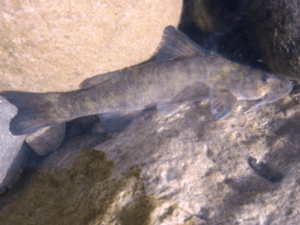Diplomystes nahuelbutaensis facts for kids
Quick facts for kids Diplomystes nahuelbutaensis |
|
|---|---|
 |
|
| Conservation status | |
| Scientific classification |
The Diplomystes nahuelbutaensis is a special type of velvet catfish. It is found only in Chile, making it an endemic species. This unique fish lives in the freshwaters of the Bío-Bío River basin and the Loncomilla River.
This catfish can grow up to about 26 centimeters (around 10 inches) long. It is sometimes caught by local fishermen for food and is also popular with people who enjoy fishing for sport.
Contents
What is a Velvet Catfish?
Velvet catfish are a group of fish known for their smooth skin, which feels like velvet. Unlike many other fish, they do not have scales. They often have long whiskers, called barbels, around their mouths. These barbels help them find food in murky water.
The Diplomystes nahuelbutaensis is part of the Diplomystes family. This family is very old and unique to South America. Scientists study them to learn about how fish have evolved over time.
Where Does It Live?
This specific catfish lives only in certain rivers in Chile. Its main homes are the Bío-Bío River basin and the Loncomilla River. These rivers are in the central part of Chile.
The fish prefers freshwater environments. It often lives in areas with clear, flowing water. It might hide among rocks or plants at the bottom of the river.
What Does It Look Like?
The Diplomystes nahuelbutaensis has a body shape typical of many catfish. It has a broad, flattened head. Its eyes are usually small.
The fish has several fins that help it swim and balance. Its color can vary, often blending in with the riverbed. This helps it stay hidden from predators and prey.
What Does It Eat?
Like many catfish, the Diplomystes nahuelbutaensis is likely an omnivore. This means it eats both plants and other small animals. It probably uses its barbels to sense food in the water.
Its diet might include small insects, worms, and tiny crustaceans. It could also eat plant matter or algae found in the river.
Is It in Danger?
The conservation status of Diplomystes nahuelbutaensis is listed as "Data Deficient" (DD) by the IUCN. This means scientists do not have enough information to know if the fish population is healthy or if it is at risk.
More research is needed to understand how many of these fish exist. It is also important to study what threats they might face. Threats could include pollution, changes to their river habitats, or overfishing. Protecting their unique river homes is key to ensuring their survival.
Images for kids
See also
 In Spanish: Diplomystes nahuelbutaensis para niños
In Spanish: Diplomystes nahuelbutaensis para niños



